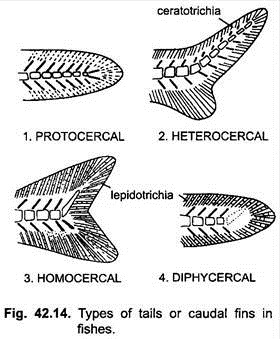The vertebral column of fishes has two types of vertebrae, trunk vertebrae and caudal vertebrae; the anus marks the point of transition between the two types of vertebrae. The vertebrae are amphicoelous.
Types of tails or caudal fins:
In fishes the shape of the tail is correlated with the direction taken by the terminal portion of the notochord or vertebral column.
1. Protocercal:
When the notochord extends straight to the tip of the tail and the caudal fin is divided equally then the tail is protocercal, as in embryonic fishes, adult cyclostomes, and some amphibians.
2. Heterocercal:
ADVERTISEMENTS:
Heterocercal tail has the vertebral column bent upwards in the posterior region so that the caudal fin is divided into a narrow dorsal lobe and a broader ventral lobe. It is typical of elasmobranchs (Scoliodon) and some lower bony fishes. The heterocercal tail made its appearance after the protocercal tail, and it gave rise to the next two types of tails.
3. Diphycercal:
Diphycercal tail has lost the terminal upturned part of the vertebral column, and the vertebral column does not reach the end. Externally the tail has become symmetrical secondarily having two equal lobes of the caudal fin. It is found in Dipnoi, Polypterus and Latimeria.
4. Homocercal:
In homocercal tail, the terminal part of the vertebral column is bent upwards, but the dorsal lobe of the caudal fin is lost during development and the ventral lobe divides into two equal parts, so that the caudal fin appears symmetrical externally. This tail is common in bony fishes.
5. Hypocercal:
ADVERTISEMENTS:
Hypocercal tail has a larger lower lobe of the caudal fin into which the vertebral column is bent downwards. It is found in some primitive fishes and in extinct reptiles called ichthyosaurs.
